Jonathan Gold’s 10 best dishes of 2016
- Share via
2016, by all accounts, was a year from which we will not soon recover; a year when the social-media obsessives among us were reduced to peeking at Twitter feeds between their fingers. But the food wasn’t bad – the year saw the rise of Filipino cooking, a wave of woman chefs and the resurgence of vegetable-based cuisine; walls of fermentation crocks that made dining rooms resemble biology labs; and an interest in whole, locally grown grain. We waited in line for dinner in 2016, often in obscurely located mini-malls. We realized that Vietnamese cooking was regional. We ate lots of Things in a Bowl. And somehow, there were always tacos. Can we make sense of 2016 in Los Angeles with a list of 10 unrelated dishes? Probably not. But we can eat awfully well.
Chat with Jonathan Gold on Facebook Messenger »
For the record:
7:26 p.m. Aug. 8, 2019An earlier version of this post showed an incorrect photo for the Cha ca La Vong at Pok Pok.
Zha jiang mian
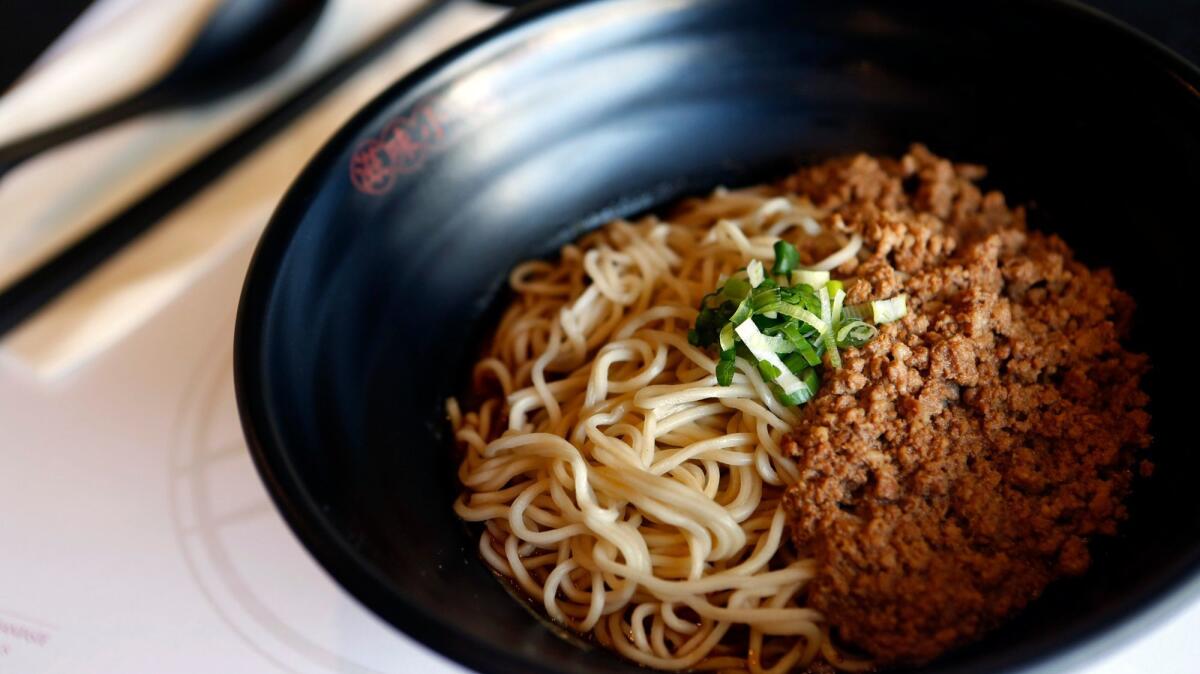
Valley Boulevard, as you may have noticed, has become almost a Little Sichuan, a thoroughfare lubricated with scarlet chile oil, with new restaurants opening every few weeks. If you yearn to have your head blown sideways by the ferocity of Sichuan hot pot or the intense flavors of water-boiled fish, you will not do better in North America. And the most impressive new Sichuan dish I tasted this year, surpassing even the shredded pork with garlic at the Legendary Restaurant and the bullfrog at Dezhuang Morals Village, may be the zha jiang mian at Mian, the new Chongqing-style noodle house opened by Tony Xu, the chef behind the astonishingly popular Chengdu Taste.The surface of the noodles, served in or out of broth, is paved with ground pork and scallions; the noodles themselves have a distinct chewy pull. These are noodles with a mean streak, a potent lashing of hot chile and oil, laced with just enough Sichuan peppercorn to numb the pain of the pure chile heat. If you want an extra jolt of starch, try the zha jiang mian laced with a handful of soft peas imported from Chongqing. 301 W. Valley Blvd., No. 114-115, San Gabriel, (626) 693-6888, mian.us.
Farinata
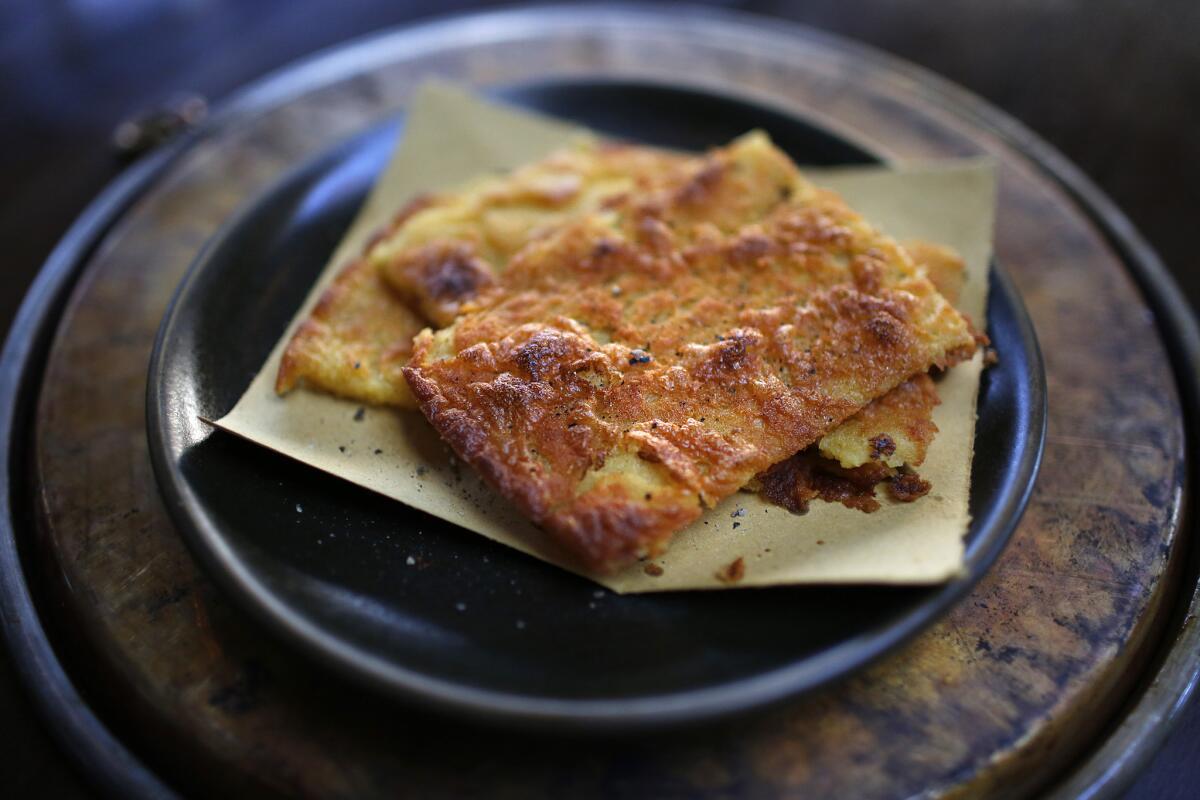
Officine Brera is the grand, serious Italian restaurant Los Angeles had been yearning for, booming opera arias instead of EDM, wood-grilled steaks if you’re into that sort of thing, and a wonderful repertoire of rice dishes. The chef is Angelo Auriana, whom you may know from Factory Kitchen or from his many years at Valentino. It’s a nice place to come for lardo with honey, boiled veal tongue with olives, or pisarei e fasö, tiny flour dumplings cooked with borlotti beans. But what may be the best dish in the restaurant comes from seaside Genoa, and isn’t even on the menu — farinata: a warm slice of a massive crepe cooked in the wood oven, whose ingredients include not much beyond chickpea flour, water, olive oil and salt. Auriana’s farinata is softer than it is crunchy, with a vague tartness from slightly fermented batter and served from a wheeled cart barely big enough to hold the heavy copper pan. It is exactly what you want to be snacking on when the first Negronis arrive. 1331 E. 6th St., Los Angeles, (213) 553-8006, officinebrera.com.
Legumes de saison
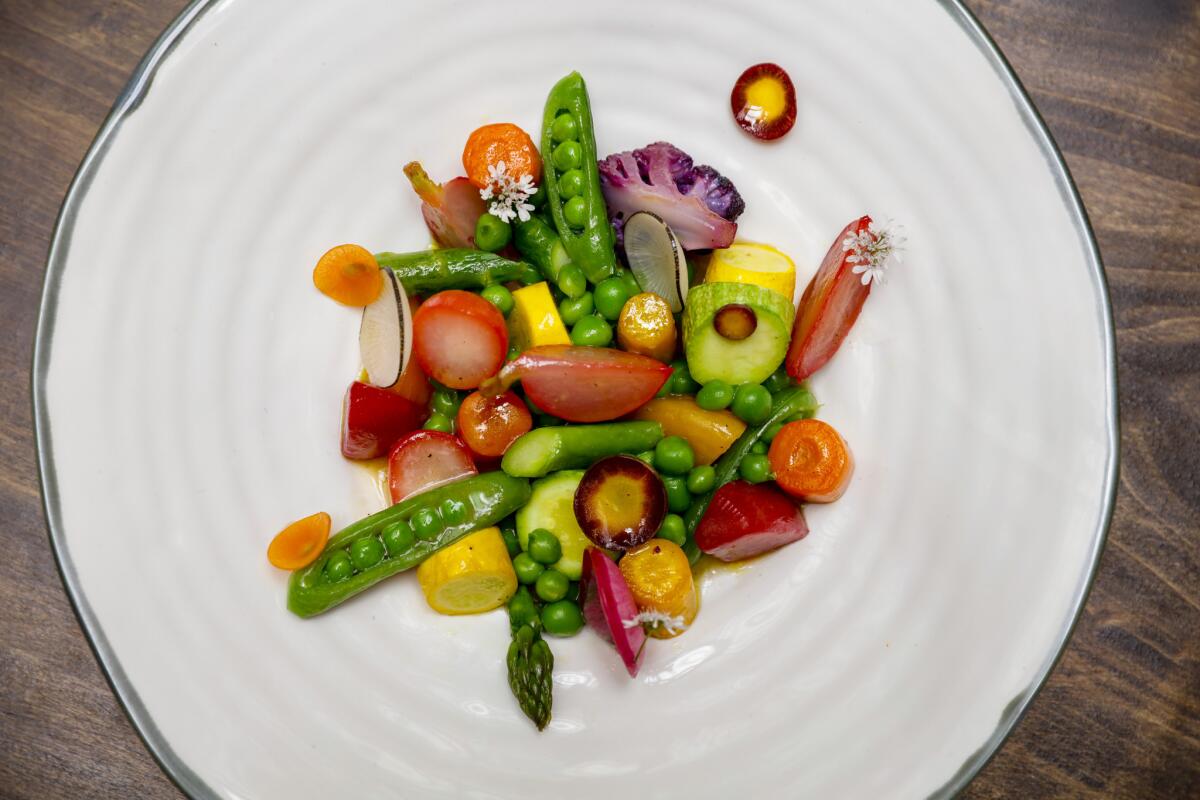
Spring is the loveliest French restaurant to open in Los Angeles in years, a 19th-century courtyard graced with enough foliage to green up a small estate, and the sunny Provençal cooking of Tony Esnault, who came to Los Angeles after many years with Alain Ducasse. Downtown is better off for his snail salad with tomato and fennel, his wild striped bass with lemony breadcrumbs, and his spectacular version of the Provencal fish stew bourride. Yet the best dish on his menu may be this complex, changing composition of a dozen or so beautifully turned vegetables that always seems to capture the essence of the season. Each of the vegetables is cooked separately — steamed, roasted, sautéed in olive oil — and each of them tastes vibrantly of itself, but melds into that bright, high note of time and place. Nobody spends this amount of time on a dish merely to have a vegetarian option on his or her menu: The dish is a mic drop from a supremely talented chef. 257 S. Spring St., Los Angeles; (213) 372-5189; springlosangeles.com.
RELATED: Restaurant reviews from Jonathan Gold >>
Galbi jjim
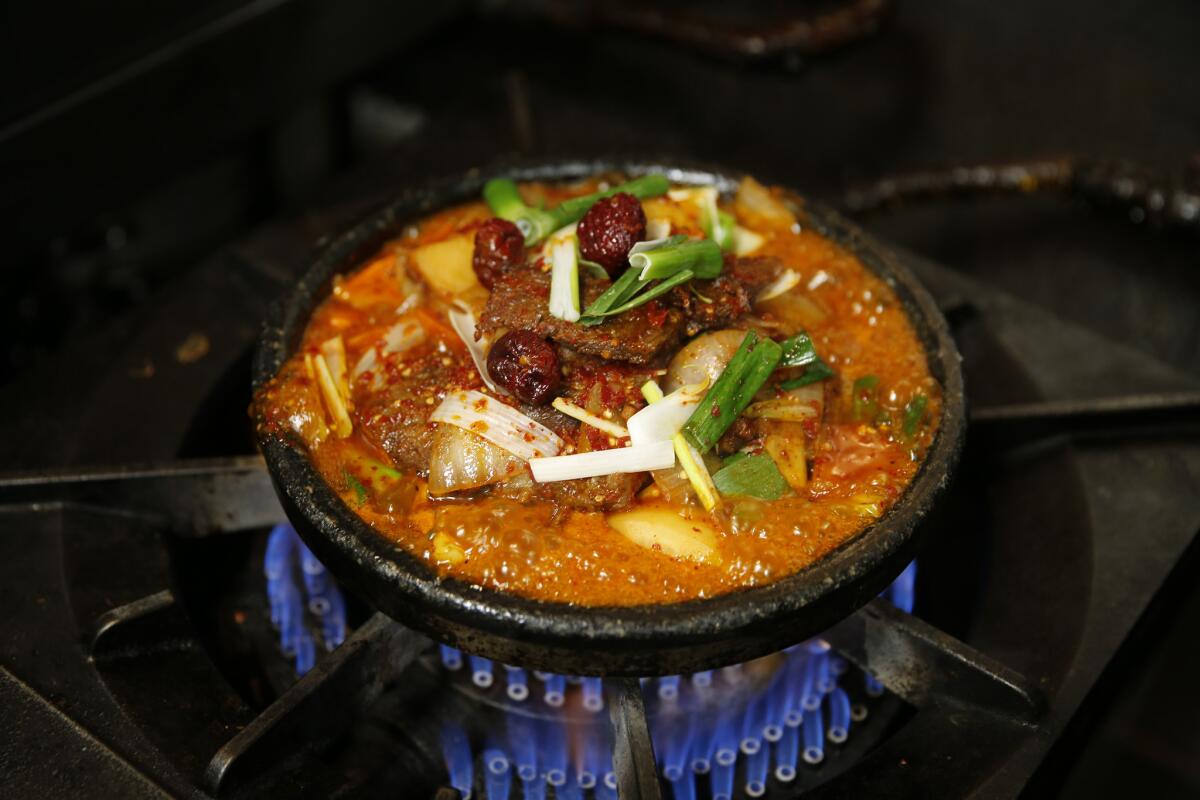
Sun Nong Dan is named after an archaic term for sullongtang, the soothing bone broth famous for its qualities as a morning-after tonic that is presumably why the restaurant is open 24/7. But the swelling crowd outside the tiny Koreatown storefront is there for the short-rib stew, galbi jjim, which is pretty much everything about Korean cooking cranked up to 10 — a mountain of meat and vegetables rising out of a violently red lagoon of spicy broth, enveloped in its own small universe of garlicky steam. If you have ordered it with cheese – you have to order it with cheese – a waiter scoops a big handful of white gratings over the top and goes at it with a torch. If you are recording the spectacle on your phone, he may conjure a fireball or two for your Snapchat feed. Galbi jjim is a staple of both royal Korean cuisine and Sundays at grandma’s house. At Sun Nong Dan, galbi jjim is David Choe blasting spray paint onto an alley wall. Sun Nong Dan, 3470 W. 6th St., Los Angeles, (213) 365-0303, sunnongdan.com. Also at 927 E. Las Tunas Drive, Suite J, San Gabriel, (626) 286-1234.
Pancit
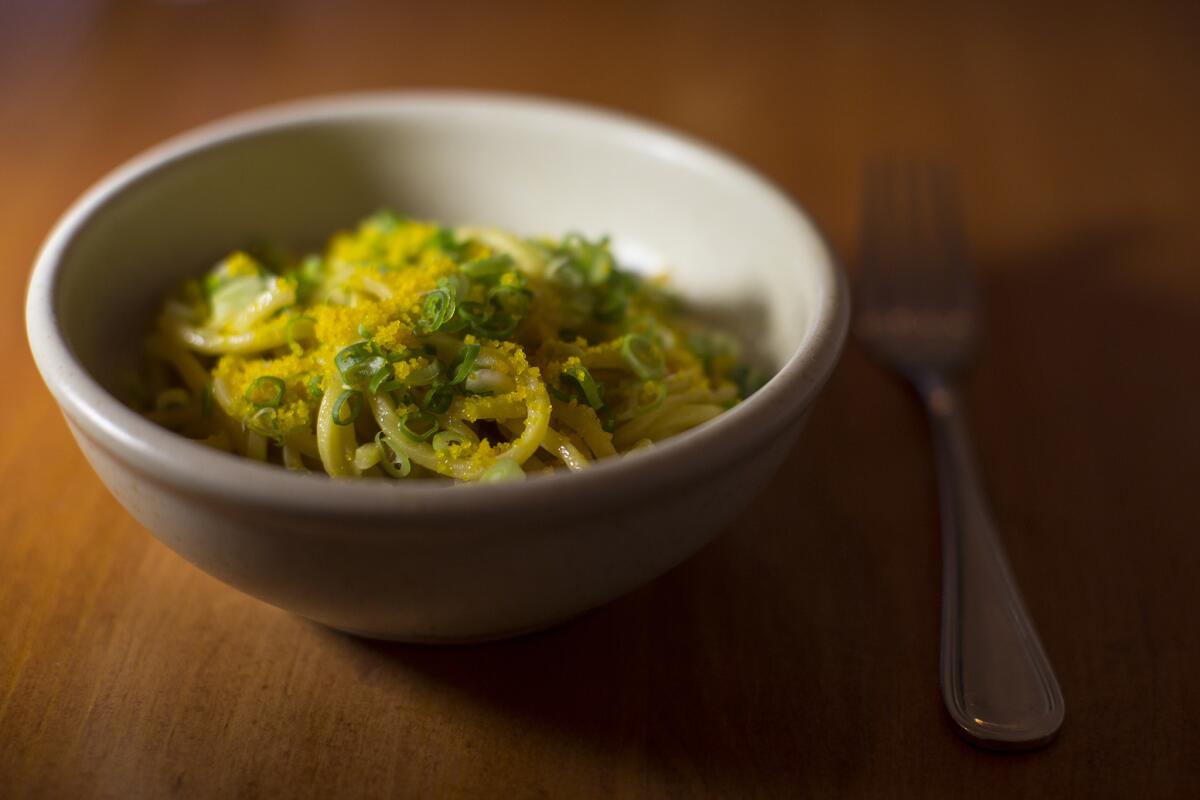
We are finally going through a Filipino food renaissance in Los Angeles, not just the usual halo halo and adobo, but the gooey pork adobo fries at Belly and Snout, the peppery smoked tri-tip at Park’s Finest, the longanisa grain bowls at Rice Bar, the fried fish at Amboy and the lovely pinirito at Irenia. But nobody has quite caught the spirit of modern Filipino cooking like LASA, the Thursday through Sunday pop-up in the Unit 120 restaurant incubator space in Chinatown. Chad Valencia’s cooking captures the regionality of the dishes in the Philippines’ zillion islands, refreshing vinegar and citrus notes, and a lightness that you may have never before seen in Filipino cooking. So what seems to be a simple bowl of pancit noodles becomes a complex composition balancing butter, a bit of fragrant calamansi lime juice, and shavings of egg yolk that has been cured with patis, the strong Filipino fish sauce … it’s less street food than an umami-rich Filipino wink at spaghetti carbonara. LASA, at Unit 120, 727 N. Broadway, Los Angeles, (213) 443-6163, lasa-la.com
Cucumbers stuffed with shiso
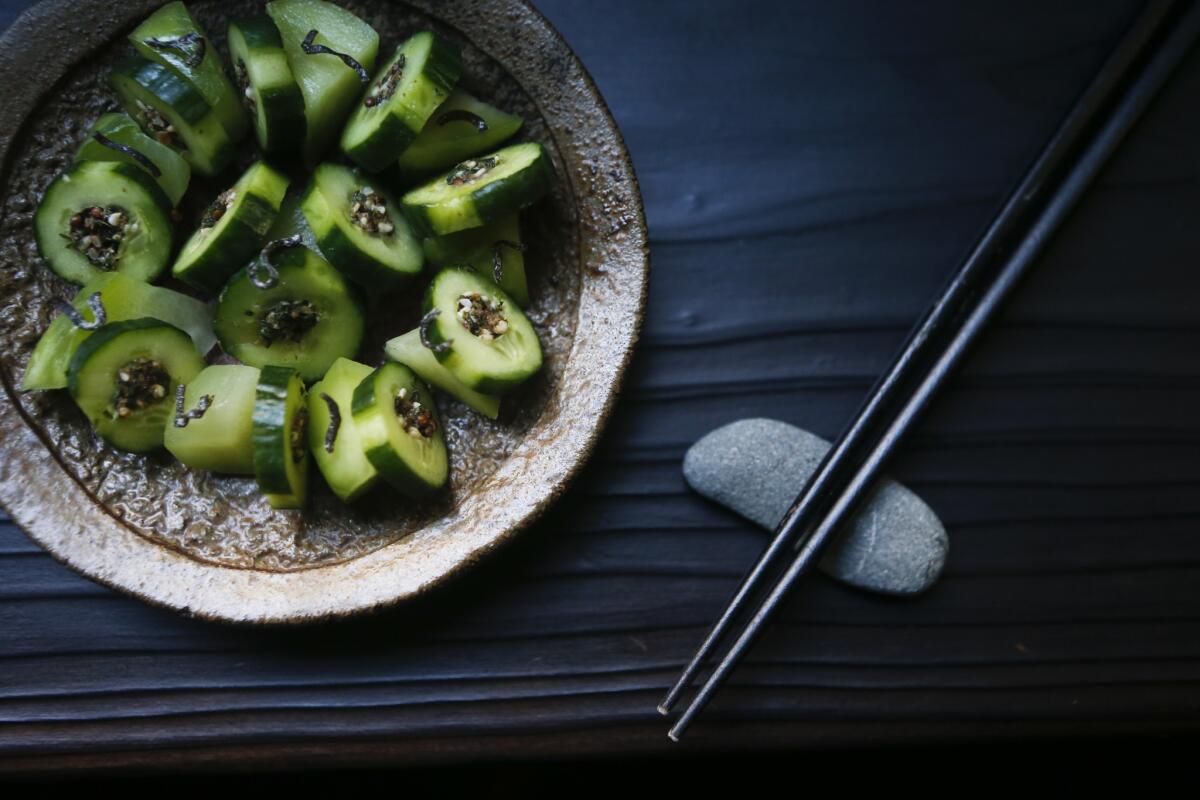
Shibumi, a modest, season-dependent kappo-style restaurant, feels like a Tokyo restaurant in important ways, a dim, hidden showcase for David Schlosser’s precise Japanese cuisine. So why, amid a stream of unusual fermentations, rare fish and grilled beef, might you come away dreaming of a lightly salted cucumber? The vegetable has been sliced, peeled in a fashion that makes its skins look like watered silk, thickly sliced and arranged in an earthen bowl. The seeds at the center have been replaced with slivered shiso leaf, pickled plum, crunchy seeds and chewy, smoky bits of bonito. When you bite into a thick slice, it explodes with flavor but not quite with juice; the short cure has rendered the vegetable crisp and delicate, with a kind of tautness where you might expect the crunch. It is hard to imagine anything that might go better with the first sake of the evening. 815 S. Hill St., Los Angeles, (213) 265-7923, shibumidtla.com.
Cha ca La Vong
Pok Pok, Andy Ricker’s cavernous restaurant at the north end of Chinatown, is best known for its faithful, pungent renditions of dishes from rural northern Thailand, salad-like assemblages of strong herbs, grilled meat and dried fish powerful enough to flavor vast quantities of rice. The Thai drinking food – toasted dried squid, fried chopped gourami, cured pork grilled in banana leaves – is especially brilliant with drafts of ice-cold beer. So why do the two best dishes on the menu, the fish-sauce fried chicken wings and the clay pot catfish, come from Vietnam? Hard to tell, although the menu attributes the wings to Portland Pok Pok cook Ich Truong. But I’ve never tasted a better local version of cha ca: a turmeric-marinated catfish fried with vast amounts of fresh dill, served with peanuts and slippery vermicelli, from the famous Old Town Hanoi restaurant Cha Ca La Vong. Essential. 978 N. Broadway, Los Angeles, (213) 613-1831, pokpokla.com.
Roast dumpling squash
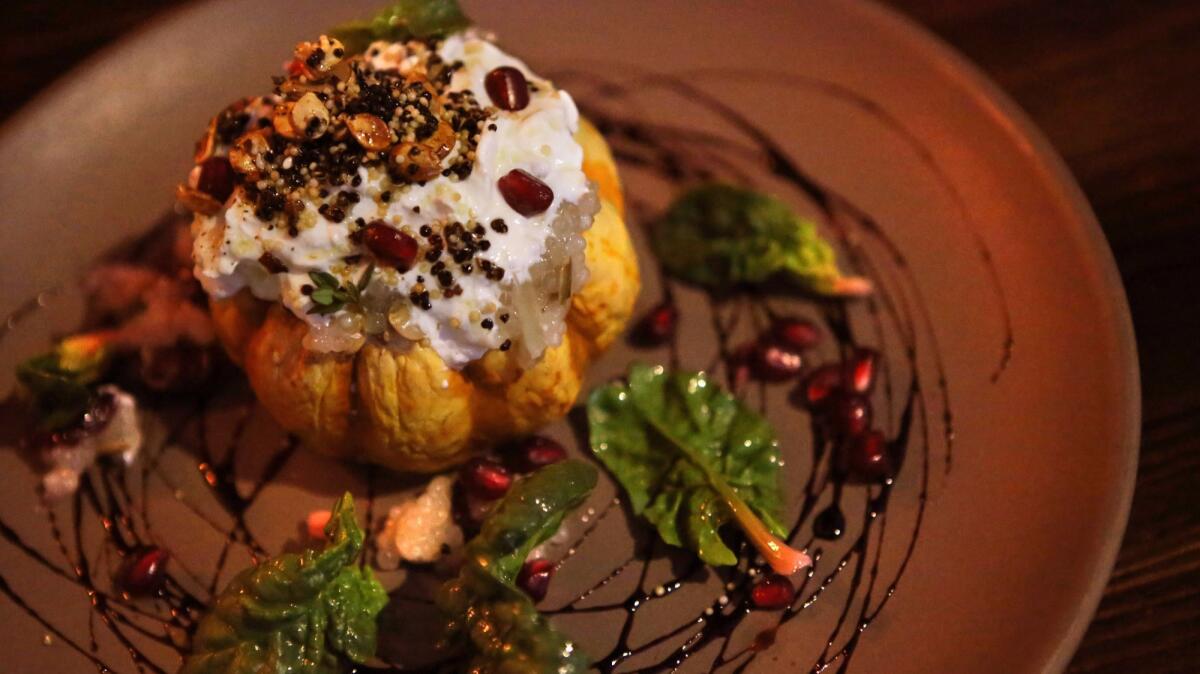
Whole roasted vegetables have become almost as easy to find in Los Angeles as avocado toast, but I’m not sure I have ever come across a presentation as striking as the roast dumpling squash that Nyesha Arrington serves at her Venice restaurant Leona, a platter that could have come out of a 17th century Dutch still life: upright, striped squashes stout as barrels, sprinkled with seeds and crinkly leaves, oozing milky burrata cheese. The skin is thin and tender, but it still gets between your teeth, and the seeds steam nicely inside the squash, but you may never have — I never had — quite dealt with eating the stringy part before. Arrington plays up the sliminess a bit by including cooked pearls of tapioca, as well as crisped quinoa, whose crunchiness you won’t immediately be able to trace. There is a bit of aggression to this squash. It’s a statement of purpose. 123 W. Washington Blvd., Venice, (310) 822-5379, leonavenice.com.
Roast turnip
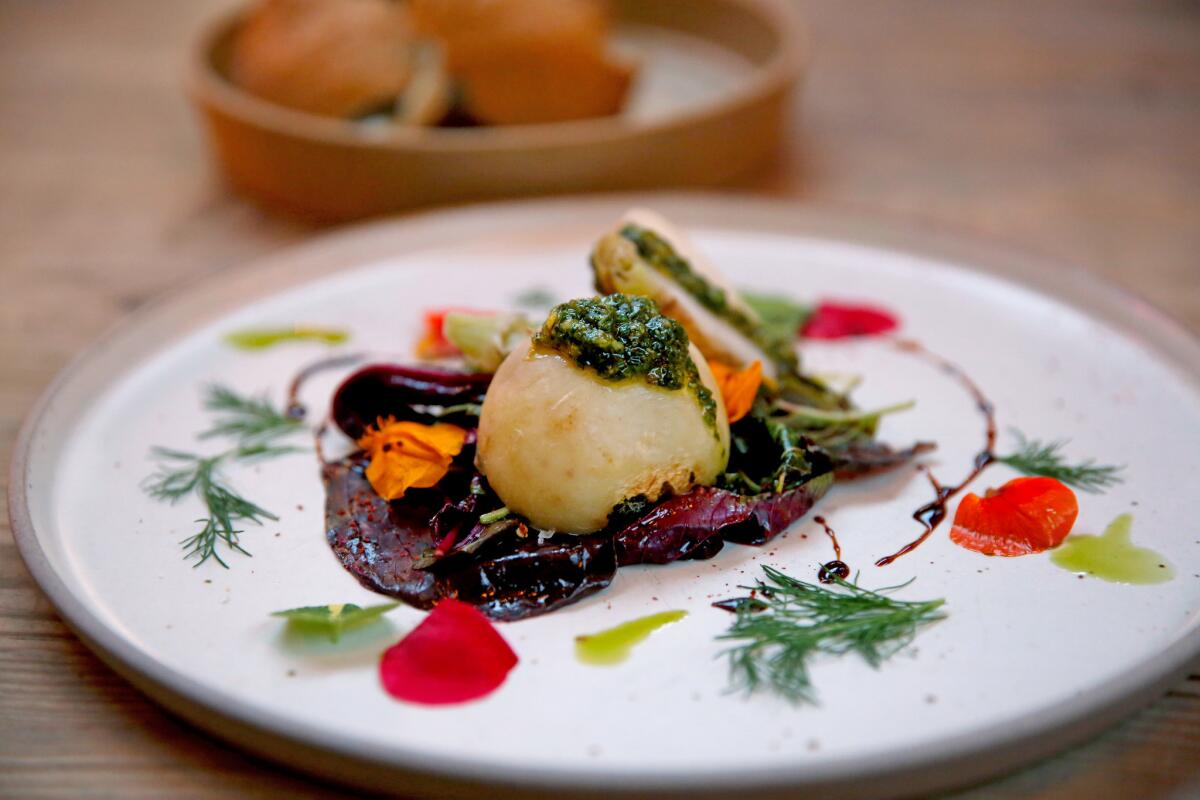
Are we still talking about whole roasted vegetables? It appears that we are. But it would be hard to do a list like this without including the star of the menu at PYT, Josef Centeno’s new vegetarian-ish restaurant downtown – a peeled turnip wrapped in a big, anise-y hoja santa leaf, encased in a salt-dough crust and baked for hours until the turnip flavors condense into an essence that hits your tongue like syrup. Centeno cracks open the salt crust of the turnip at the table. He pries off the shards, carefully extricates the vegetable from its fragrant shroud, and carves the pristine white orb like a grand roast before he dabs on a bit of bright-green chimichurri sauce in which the chopped parsley is supplemented by the Japanese herb shiso. The first few bites are unmemorable – it’s a turnip! – but at the very center there is a bite or two in which the shiso, the licorice-y hoja santa and the vegetable sing in reedy harmony. Lovely. 400 S. Main St., Los Angeles, (213) 687-7015, pytlosangeles.com.
Pork chop
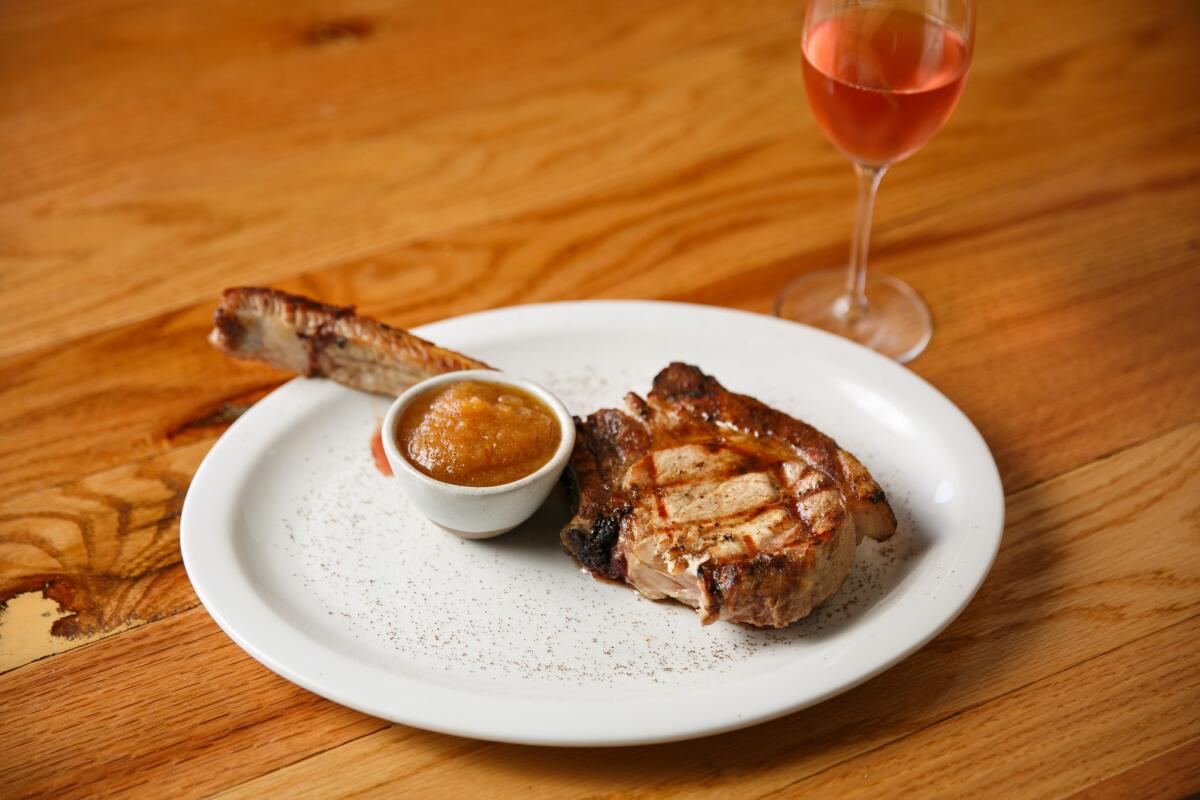
Could the best pork chop in town be the one Chris Phelps and Zak Walters serve at their relocated Salt’s Cure? It just might be — a full pound of sustainably raised Marin Sun Farms pork from Northern California, lightly marinated and cooked slowly, so that the thin rim of fat crisps while the juices concentrate in the meat and the pork tastes intensely, gloriously of itself. It’s a pork chop, but it is also a tour de force. “I’d been at my last restaurant for almost eight years,” a server confessed. “But I wanted to work with people who could cook a pork chop like that.’’ See if you can score a short stack of the buttery, crisp-edged oatmeal griddle cakes to go along with the chop. It sounds weird, but the combination deserves to be classic. 1155 N. Highland Ave., Hollywood, (323) 465-7258, saltscure.com.
ALSO
Jonathan Gold’s 101 Best Restaurants
Jonathan Gold didn’t expect a Nick Erven vegan restaurant, but it might be L.A.’s best vegan dining
Jonathan Gold finds strong flavors and a splendid bar at Here’s Looking at You in Koreatown
More to Read
Eat your way across L.A.
Get our weekly Tasting Notes newsletter for reviews, news and more.
You may occasionally receive promotional content from the Los Angeles Times.











